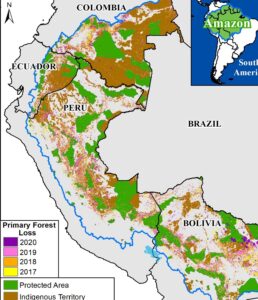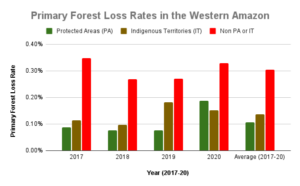Protected Areas and Indigenous Territories Prove to be the Best Defense against Deforestation for the Western Amazon
July 29, 2021
 Washington, DC, July 27, 2021. A new analysis by Amazon Conservation’s Monitoring of the Andean Amazon Project (MAAP) shows that protected areas and indigenous territories offer the best defense against deforestation for the Amazon Rainforest.
Washington, DC, July 27, 2021. A new analysis by Amazon Conservation’s Monitoring of the Andean Amazon Project (MAAP) shows that protected areas and indigenous territories offer the best defense against deforestation for the Amazon Rainforest.
Through Amazon Conservation’s latest Monitoring of the Andean Amazon Project (MAAP) analysis, the organization studied how land use designations in the four countries of the western Amazon – Bolivia, Colombia, Ecuador, and Peru – impacted primary forest loss in 2020.
The primary finding solidifies the importance of protected areas and indigenous territories as key mechanisms to fight deforestation.
“The results speak for themselves,” says lead author Dr. Matt Finer, Director of Amazon Conservation’s MAAP. “They strongly show that protected areas had the lowest recent deforestation across the western Amazon, closely followed by indigenous territories. Protected areas in Ecuador and Peru and indigenous territories in Colombia were especially effective.”
The results showed that, across an area of 229 million hectares (568 million acres), lands designated as protected areas, covering 43 million hectares, had the lowest rates of primary forest loss, followed closely by those designated as indigenous territories, covering 58 million hectares. 2020, a year marked by the COVID-19 global pandemic, presented a peak in forest loss in the Amazon as well as a flip in this overall pattern, with indigenous territories having less primary forest loss than protected areas. This increased forest loss in protected areas last year was primarily due to intense forest fires in Bolivia.
 Areas with other land use designations had deforestation rates that were two times higher than in protected areas and indigenous territories.
Areas with other land use designations had deforestation rates that were two times higher than in protected areas and indigenous territories.
“This data helps reinforce that protected areas and indigenous territories are doing their intended job in safeguarding these irreplaceable forests and the region’s ecological function and services,” says John Beavers, Executive Director at Amazon Conservation. “However, in addition to creating protected areas and helping indigenous peoples reinforce their territorial rights, greater investment is needed to protect them from increased deforestation threats and to build these areas’ resilience in the face of climate change. Strengthening ongoing management and their ability to adapt will provide the continued conservation needed to help the Amazon survive.”
To see the full study, visit MAAProject.org.
——-
About the Amazon Conservation Association
Amazon Conservation is a pioneering Alliance of local conservation organizations — Conservación Amazónica-ACEAA in Bolivia, Conservación Amazónica-ACCA in Peru, and Amazon Conservation in the United States — working towards a thriving Amazon. The organization’s holistic approach focuses on protecting wild places, empowering people, and putting science and technology to work for conservation. Visit amazonconservation.org for more information.

